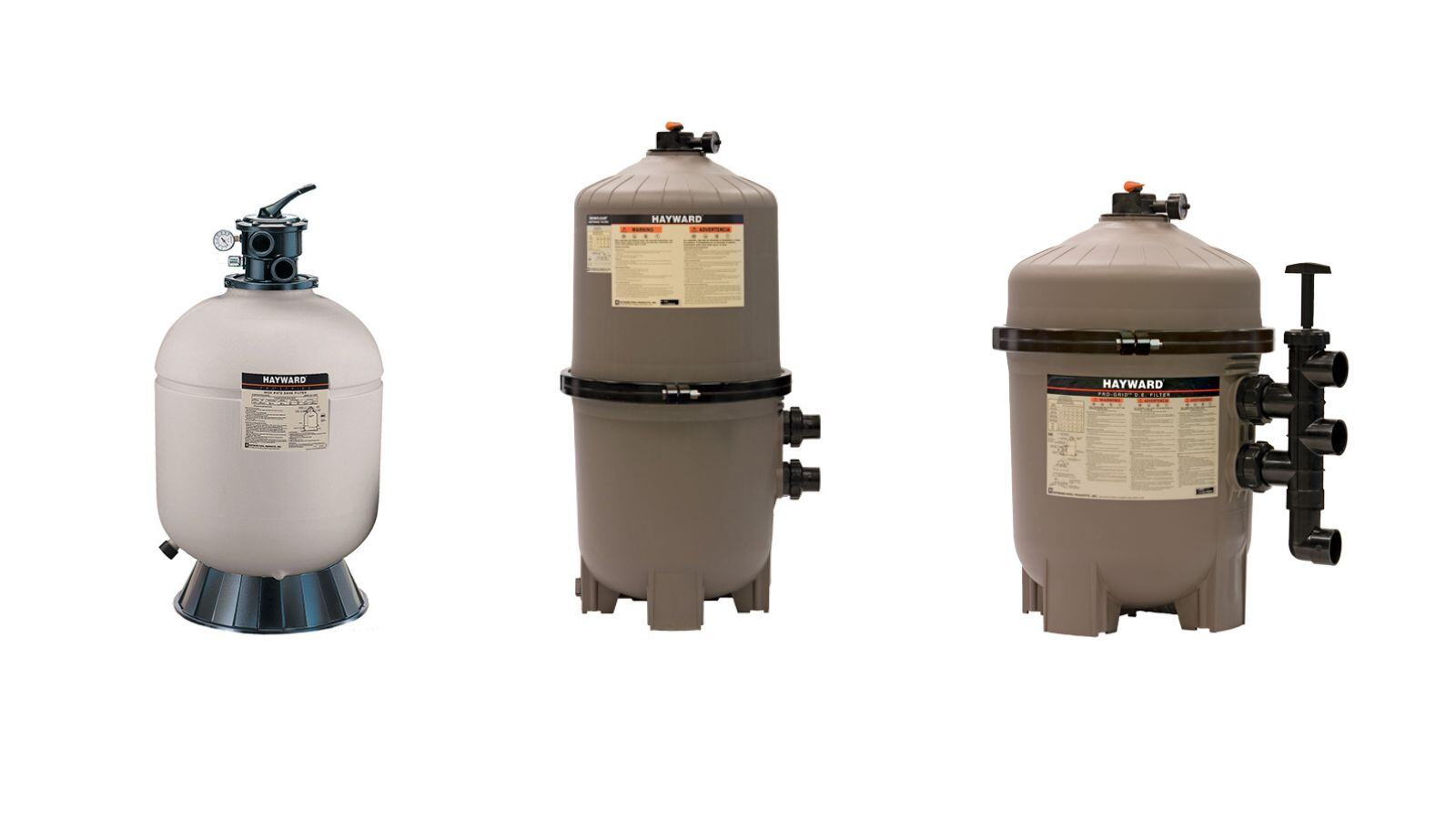Pool Filters 101: Choosing the Best Filtration System for Your Pool
Choosing the Right Pool Filter: A Complete Guide
4 min read
JC Escudero : Jul 8, 2025

Selecting the right pool filter is crucial for maintaining crystal-clear water in your pool. There are four main types of pool filtration systems: sand (media), diatomaceous earth (DE), cartridge, and centrifugal pre-filters. Each type has advantages, maintenance requirements, costs, expected lifespan, size considerations, and hydraulic needs. Let’s break them down so you can make the best decision for your pool.
A pool filter is the heart of the circulation system, responsible for removing dirt, debris, and microscopic contaminants from the water. Without a properly functioning filter, water clarity suffers, and the entire pool ecosystem can become compromised. An undersized or poorly maintained filter can lead to clogged pipes, reduced flow rates, or a failure to meet the effective water flow requirements within the unit, and strain on other equipment, such as pumps, heaters, and chlorinators, causing premature failure. Selecting the right filter size and type ensures efficient circulation, prolongs the life of pool components, and keeps your water sparkling clean.

Sand filters use specially graded silica sand to trap debris as water passes through. Over time, trapped particles make the filter more efficient until backwashing is needed to flush out accumulated dirt. Glass media is also an option instead of using sand, depending on local requirements for the disposal of sand.
Initial Cost: $1,000–$2,500
Media Replacement: Every 3–5 years (~$100–$400)
Backwashing Frequency: Every 1–2 weeks. Average time to open and replace the sand 1 hr+
Micron Filtration: 20–40 microns
Lifespan: 5–10 years
Typical Diameter: 20–36 inches
Height Range: 30–50 inches
Footprint Considerations: Requires ample space for backwash plumbing and access to a multi-port valve.
Flow Rate: 50–100 GPM (varies by model)
Max Flow Rate: Exceeding max GPM can cause channeling, reducing filtration efficiency.
Lower initial cost
Simple to maintain with good access, additionally, budget for the cost of media (sand, glass, and labor to replace)
Long lifespan
Requires frequent backwashing (resulting in water waste) and a sewer discharge is required.
Less effective filtration compared to DE and cartridge filters
.jpg?width=249&height=332&name=Filter%20Vertical%20Blog%20Visual%20(3).jpg)
Diatomaceous Earth (DE) is a naturally occurring, highly porous material made from the fossilized remains of microscopic aquatic organisms called diatoms. These tiny skeletons are composed of silica, which gives DE its exceptional filtration properties. DE filters use this fine powder to coat the grids inside. This material captures smaller particles than sand filters. Backwashing these is very important to keep the filter from clogging.
Initial Cost: $1,000–$3,000
DE Powder Replacement: After every backwash ($70–$100 annually)
Backwashing Frequency: 4–6 weeks. (Sewer discharge required). The average time to clean inside or replace the grids is more than 1 hr.
Micron Filtration: 3–5 microns
Lifespan: 10+ years (with proper maintenance)
Typical Diameter: 24–48 inches
Height Range: 36–60 inches
Footprint Considerations: Requires sufficient clearance for backwash piping and grid removal for cleaning purposes.
Flow Rate: 60–120 GPM (varies by model)
Max Flow Rate: Exceeding GPM limits can damage internal grids and reduce effectiveness.
.jpg?width=257&height=343&name=After%20fire%20Vertical%20Blog%20Visual%20(2).jpg)
Backwashing a DE filter flushes used DE powder and trapped debris out of the system. In many areas, this wastewater is regulated due to concerns about DE powder entering storm drains, which can lead to environmental pollution in oceans and waterways. Proper sewer connections are necessary to prevent discharges of DE into storm drains. Pool owners should check local codes and consider adding a separation tank or a designated disposal method to ensure compliance with environmental guidelines.
Superior water clarity (removes the smallest particles)
Long-lasting unit
Suitable for pools with high debris levels
More maintenance-intensive
DE powder disposal regulations apply in some areas
Higher upfront cost
.jpg?width=266&height=355&name=Filter%20Vertical%20Blog%20Visual%20(5).jpg)
Cartridge filters use pleated polyester filter media to trap debris. Unlike sand and DE filters, they don’t require backwashing—just periodic rinsing and occasional replacement of the filter cartridge (cylinder).
Initial Cost: $1,500–$2,500 (average sizes)
Cartridge Replacement: Every 3–5 years ($150–$400 per cartridge set)
Cleaning Frequency: Every 4–8 weeks. The average time to open and clean the cartridges is less than 1 hr.
Micron Filtration: 10–20 microns
Lifespan: 7–10 years
Size, Footprint, and Hydraulics
Typical Diameter: 18–30 inches
Height Range: 30–50 inches
Footprint Considerations: Requires sufficient space for easy cartridge removal during cleaning.
Flow Rate: 75–150 GPM (varies by model)
Max Flow Rate: Exceeding GPM can reduce cartridge lifespan and filtration efficiency.
Energy-efficient (no backwashing required)
Better filtration than sand filters
Less water waste
More frequent cleanings are required
Replacement cartridges can be expensive

These are not primary filters, but they act as a pre-filter by spinning out large debris before the water enters the main filter. They help extend the life of the primary filtration system. If you want extra help if your pool suffers from windy conditions, these are great additions to your filtration system.
Initial Cost: $800–$1100 + (Plumbing work required)
Cleaning Frequency: Every 2–4 weeks. Average time to open and clean: 10-15 minutes.
Lifespan: 10+ years
Typical Diameter: 10–24 inches
Height Range: 12–36 inches
Footprint Considerations: Compact size allows for easy integration into existing equipment setups.
Flow Rate: 40–80 GPM
Max Flow Rate: Must match primary filter GPM to avoid flow restrictions.
Extends the life of the main filters
Reduces backwashing needs
Low maintenance
Does not replace a primary filtration system
.jpg?width=230&height=306&name=Filter%20Vertical%20Blog%20Visual%20(2).jpg)
When selecting a filter, it’s important to size it correctly based on your pool’s volume and the rest of your equipment. Many filters are undersized, leading to inefficient water circulation. Factors like pump strength, a heater not working due to a poor flow rate, Additional water features should all be considered in hydraulic calculations and should have their own filter for the specific function or use.
Large pools often require two or more filters to handle high water turnover rates effectively. A properly sized filter ensures better water quality, reduces strain on your equipment, and extends its lifespan.
.jpg?width=237&height=316&name=Filter%20Vertical%20Blog%20Visual%20(1).jpg)
The pressure gauge, which displays the internal operating pressure of the unit, is a key indicator that a filter needs cleaning or backwashing. Each filter type has an optimal pressure range, and when the gauge reads significantly higher than the normal operating level, it indicates that the filter is clogged with debris. Regular monitoring of pressure levels ensures optimal filtration efficiency and prevents unnecessary strain on the system.
Each type of pool filter has its strengths and weaknesses. A sand filter may be ideal if you seek minimal maintenance and low cost. If superior water clarity is your priority, DE or cartridge filters are better choices. To achieve optimal performance, ensure your filter is properly sized to meet your pool’s specific requirements.
If you’re unsure which filtration system best suits your pool, our J Designs Pool & Spa team is ready to help! Click the link below to speak with a specialist.

Choosing the Right Pool Filter: A Complete Guide

So Good, It’ll Make Resorts Jealous! Let’s face it—anyone can throw a pool party. But only a few pull off a bash so good, so unforgettable, that...

Swimming pools aren’t just for splashing around—they’ve been shaping architecture for thousands of years! From ancient civilizations to modern...